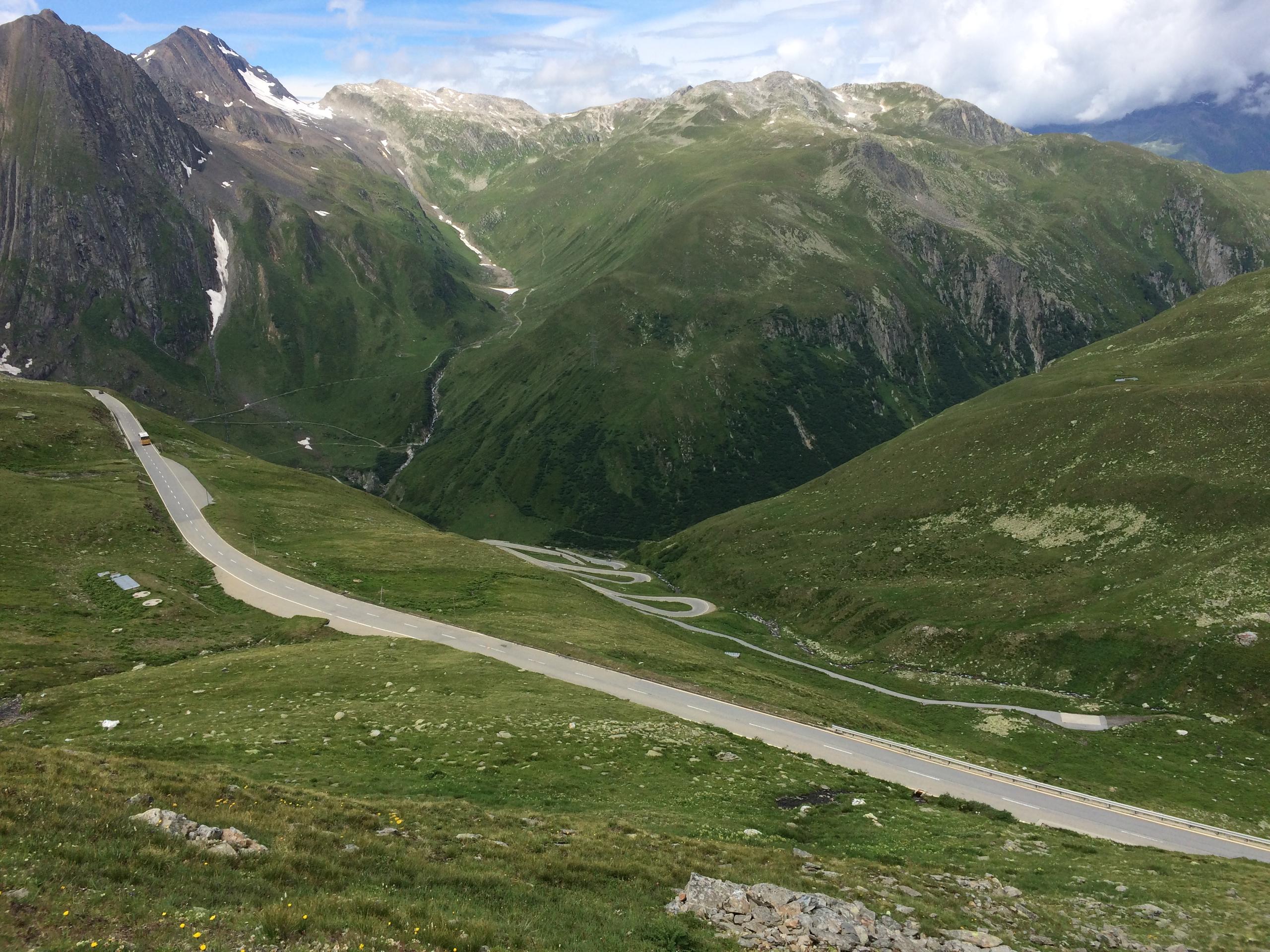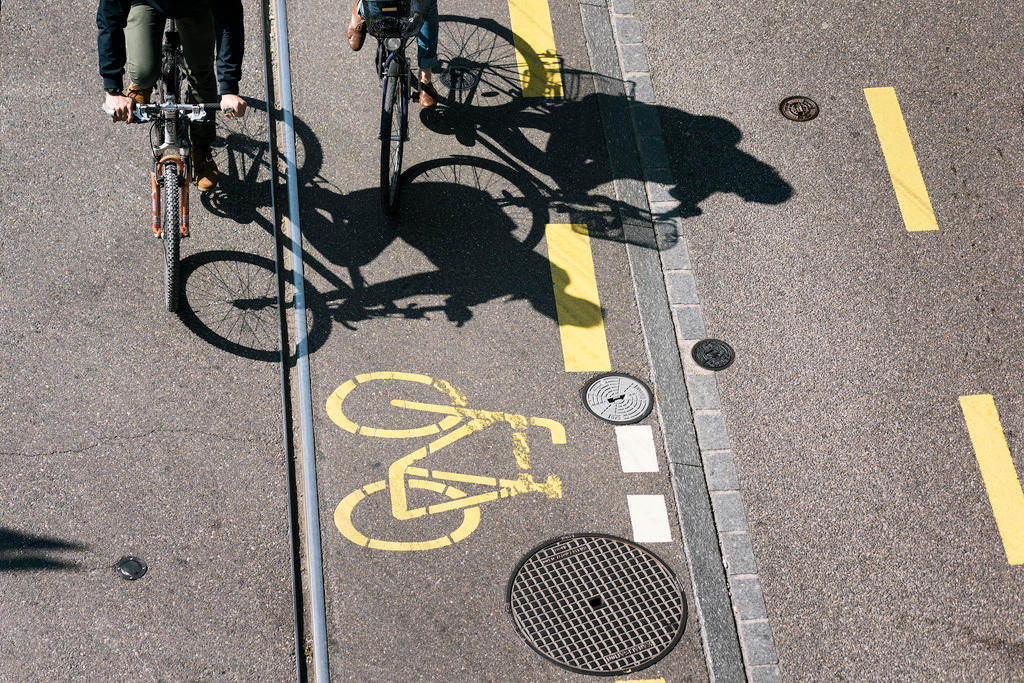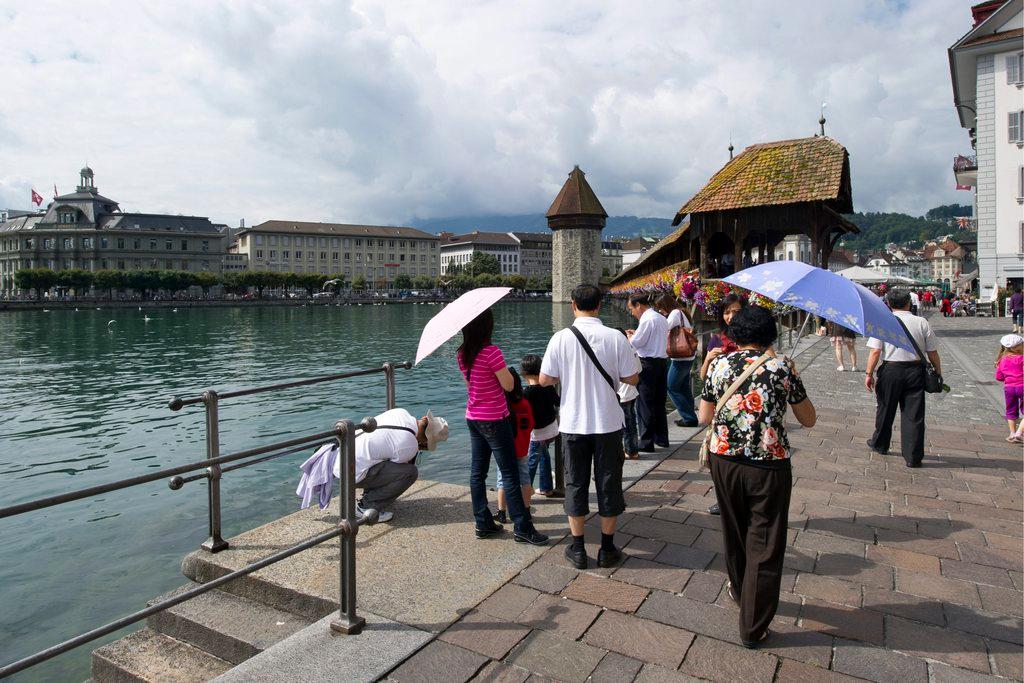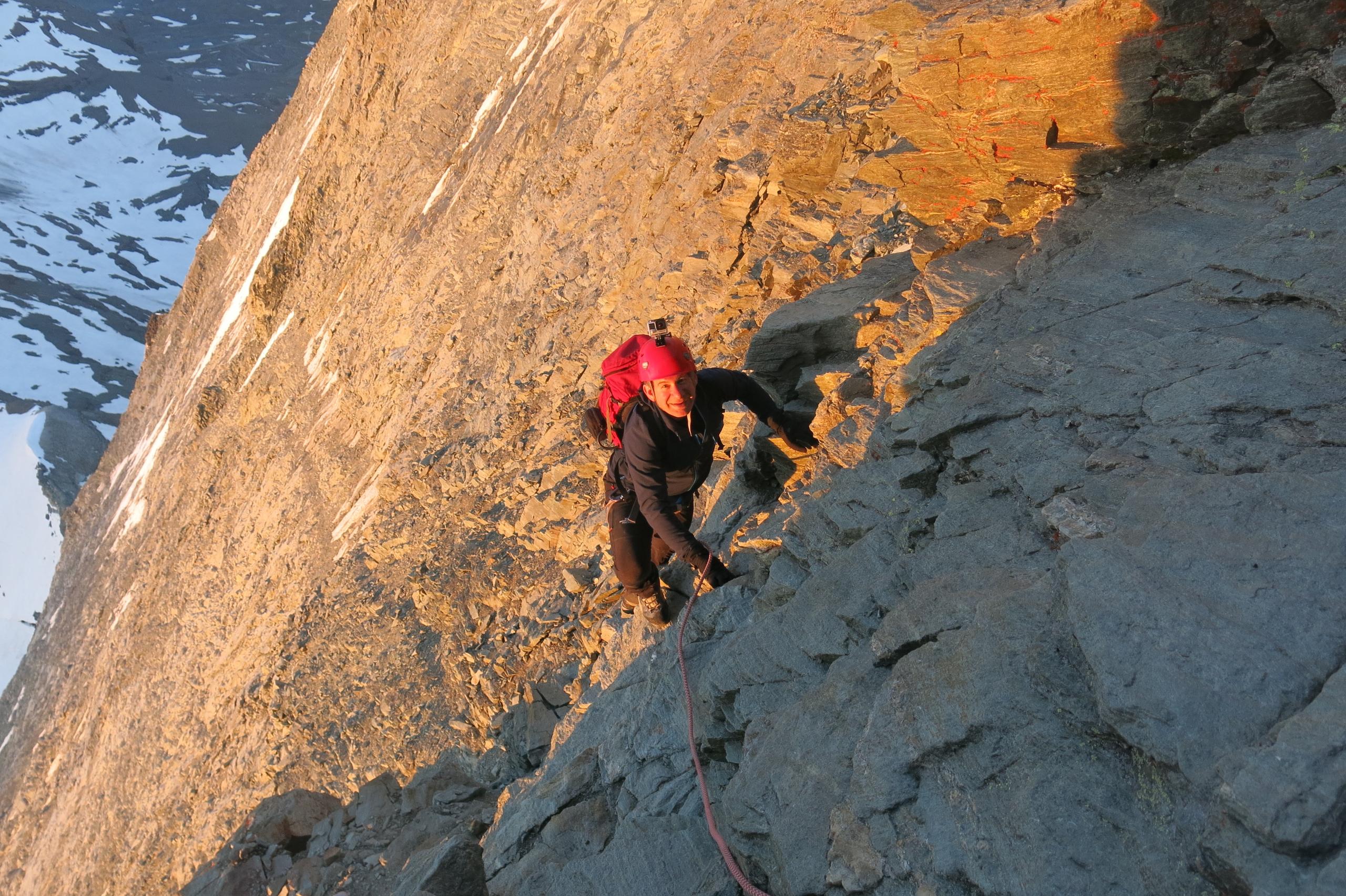Three climbs, two wheels, one day

Switzerland is one of the best-kept secrets in cycling. Why? Smooth roads, giant mountain passes, exceptional landscapes, all wrapped in the history-infused heart of Europe. After a long day among the peaks, you wonder why there aren’t more riders.
The destination was Andermatt: a small ski resort in central Switzerland where some of the country’s biggest mountain passes intersect. I arrived the evening before the ride, and I was nervous. My preparation had been patchy for a challenge which was not to be sniffed at – 3,000 metres of elevation gain in just over 100 km – and my fitness levels were much lower than usual for this time of year.
The weather also looked ominous. Andermatt, surrounded by mountains on three sides, was shadowed by grim-looking clouds, and rain was forecast for noon the next day. I was the only person eating outside the restaurant on the main square, and the waiter – in Swiss folk-costume with warm-looking knee-socks – looked upwards and muttered as he wandered around the empty tables. Tourists were scarce, despite the high-profile real estate developments in recent years, and accommodation was surprisingly easy to find.
After a pile of pasta and a short night’s sleep, I awoke early and fortunate. It was a bright, clear, fresh morning, ideal for cycling. Damp roads testified to night-time showers, but for now the sky was blue. A harbinger of a successful day? I forced down some cereal and eggs and set out before seven, to get back before the weather turned, and also – who knows? – to ensure I would have time to get through the ride before my train was due to leave, in late evening.
Hors d’oeuvre – Furkapass

More
Cycling the Alps
The first climb of the day, the Furka, began after just eight kilometres of warm-up along the false flat of the sheltered Urseren valley leading from Andermatt to the village of Realp. Switzerland’s fourth-highest paved road, the Furka tops out at 2,429 metres, a little less than a vertical kilometre above the starting point in Realp. The climb itself is 12 kilometres at an average gradient of 7.2%: a tough slog but not impossible, rather a leg-tester to gauge how much of a calvary the rest of the day would be.
And if my early-morning legs felt any pain spinning around the first section of vertiginous hairpins rising from Realp, they were neutered by the sheer excitement of what revealed itself: as the smooth road wound around and around, Alpe d’Huez-style, Realp and the valley below became smaller and smaller, and as the sun rose higher behind Andermatt I began to see patches of snow and ice glinting on the side of the three mountain chains hemming it in. It had been so long since I had ridden at this time of the morning that I had forgotten how the oblique light can create such effects; sometimes the early alarm is worth it.
Almost before I knew it I was over the first half of the climb, beyond the ridge marking the end of the hairpins, after which the valley disappears and a view of the summit emerges, nestled amid glaciers and twin peaks (from where it gets its name, Furka, the “fork”) at the end of a long, curved climb winding along the side of the mountain. This second half is, in theory, easier: the gradient eases and there are fewer hairpins. But this morning a biting wind blew down the pass and made the last four kilometres a slog. The highlight was almost running into a startled marmot crossing the road.
Over the chilly plateau at the top, the long and sweeping descent is safe and enjoyable: good roads, minimal traffic (except for a Ferrari and a Porsche enjoying an impromptu drag race) and a majestic view of the next valley floor opening before you. The Rhone, on its way to Geneva and France, is born here: just after the summit, its source glacier is visible to the south, and at the risk of stiffening up you can stop for a visit. Like Goethe, however, who described his crossing of the Furka in November 1779 – wading through snow up to the waist – I was more worried about getting down without getting too cold than stopping for the view.
The giant Nufenen

After ignoring the stacked hairpins of the Grimsel pass to the right (another climb for another day) a quick few kilometres of valley brought me immediately to the base of the second climb, the mighty Nufenen. I felt fresh after the Furka, but I knew that this was the make-or-break point of the day. The second-highest road in Switzerland at 2,478 metres, an average of 8.5%, and several stretches at over 10%: this is a beast. If I could get over intact and with some fuel left in my tank, I could always crawl up the third climb to get home.

After four kilometres of uninspiring ascent through pine trees and pastures, before the big vistas and switchbacks closer to the summit opened up, I met another rider – the first I’d seen all day. Monica was a serious triathlete, though she was taking it easy today. And as she was turning over the pedals at a similar pace to me, we stayed together and chatted to the top: the company was welcome on a climb which can only be described as steady and unrelenting, if not steeply difficult in parts.
Though living near Bern, Monica told me, between pants, that she was originally from the Uri region. She was here to train for a few days, and today was doing the exact same loop as me. Was it normal to see so few bikes on such ideal climbs? There are plenty of bikes around here, she said, but usually motorbikes… The region is not overrun with road cyclists. We saw just one other on the climb, a skinny BMC-clad rider who could easily have been a pro.
Why the lack of interest? I asked her. She didn’t know.
I said goodbye to Monica at the top of the pass: despite my legs still feeling somewhat alive, my body was drained and badly in need of calories, so I stopped into the surprisingly busy café/restaurant that looks down over the hairpins we had just climbed. I pointed at a large slice of cake. Aprikose? I asked. Abricot? The waiter looked confused. Albicocca? he said. We had crossed the border into the canton of Ticino, and were now in Italian-speaking Switzerland.
Indeed, descending the long, fast, descent towards Airolo (on the one ‘bad’ road of the day, a military-type surface of cement slabs with annoying ridges between them) the southern impressions were strong. This side of the pass is dotted with little villages more Tuscan than Teutonic, and the sun, which had clouded slightly on the pass, even came out to welcome me into the beautifully-named town of Airolo, ‘down’ at 1,175 metres.
Cobbled on the Gotthard

I would have liked to enjoy some southern comforts, but as the profile of the day made clear, what goes down must go up again: no sooner had I reached the town that the 12-km ascension of the Gotthard began. By now, despite cake and gels, I was starting to seriously flag. I had been on the road for five hours and as the forecasted black clouds moved in, I began to do what I assume even professional cyclists do sometimes – question the sheer sanity of traipsing over mountains relying on nothing except water and sugar and skinny wheels.
But if there was ever a mountain which really is worth the pain, it must be the Gotthard. For many reasons. Though it appears far from special for the first few kilometres, the road is highly symbolic: for centuries, it has been the traditional pass leading not only from northern to southern Switzerland, but from northern to southern Europe, period. The road from Germany to Italy leads through the Gotthard, and though the route literally runs ‘through’ it these days, thanks to a famous tunnel, a wonderful vestige of the past remains in the cobbled roman road which winds to the summit, up to the old Capuchin hospice, now a hotel.
And it did feel special, I admit, to make the transition from smooth tarmac to hundred-year-old cobbles with about 7 km of the climb remaining; it was special to have the road almost completely to myself, this slice of history which cars rarely use; it was special, if uncomfortable, to climb a mountain pass on such bumpy, but manageable, cobbles. And though rain arrived before the top, and my energy levels bottomed-out, the sight of the old hairpins stretching up into a seemingly summit-less gap in the mountains, surrounded by waterfalls and streams, was more than enough motivation.
It was also the first climb where there were others labouring alongside me. I passed two Brits after a few kilometres, finishing off a five-day climbing trip in the region; then an old couple with their grandson, moving at an impressive pace up the mountain, which was puzzling until I realized they were using electric bikes; then another Brit, a lean racer who left me for dead, sprinting towards the summit. Nobody was coming down, which probably wouldn’t have been a good idea on the slippery cobbles.
As for the summit, which is lively with a large carpark and several restaurants, it is another place not to hang about when the weather turns, unless you are inside for lunch. Goethe, who climbed the Gotthard from the other side during his 1779 travels (see his Letters from SwitzerlandExternal link) described a priest who had reached the summit as “so frozen that he could not bring forth a single word.” Granted, this was in November. But even in July, an extra layer would have come in useful, especially for the final descent down a damp road back to the valley. I made do with a shower and beer and a dish of fried Swiss “Rösti” potatoes in Andermatt: not a bad alternative at the end of a draining, but successful, day.
Most people think of the French Alps, the Pyrenees, or perhaps the Dolomites in Italy when it comes to mythical cycling climbs. Switzerland often lags behind, but this may be more due to circumstance than merit. Though it hosts two big stage races each year (Tour de Suisse and Tour de Romandie), neither come close to the global reach of the “Grand Tours” of France, Italy, and Spain – the number of Tour de France TV viewers, for example, is in the billions.
But the smooth roads, giant mountain passes, and spectacular scenery are increasingly earning it a reputation as one of cycling’s best-kept secrets. “A cyclist’s paradise,” said British publication Road Cycling UKExternal link last year. “Nothing halfway,” was the verdict of Bicycling MagazineExternal link, referring to the massive views and massive gradients. A series of Tour de France stages that passed through the country last year also drew interest.
A range of tour operators have emerged to cater for potential cyclo-tourists who want to explore the Swiss Alps. The official Switzerland TourismExternal link website for cycling also provides information on routes, events, and accommodation.

In compliance with the JTI standards
More: SWI swissinfo.ch certified by the Journalism Trust Initiative













You can find an overview of ongoing debates with our journalists here . Please join us!
If you want to start a conversation about a topic raised in this article or want to report factual errors, email us at english@swissinfo.ch.